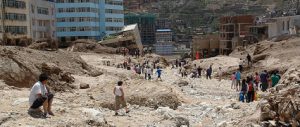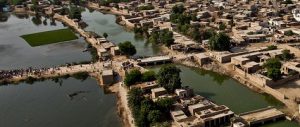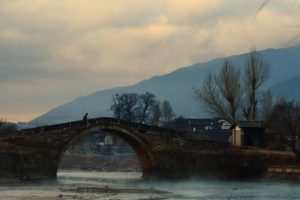On July 21, at least 37 people were killed in Beijing in the heaviest rains the Chinese capital has seen since records began more than 60 years ago.
The storm was particularly severe, but heavy downpours are not a new phenomenon for China. Memories of Guangzhou’s summer floods of 2010 remain fresh, while the loss of 22 people in Jinan city’s “July 18 downpour” in 2007 is still keenly felt.
At the time of the flooding in Jinan, the capital of China’s eastern Shandong province, senior flood official Cheng Xiaotao wrote an essay warning of the dangers posed by urban flooding. Five years later, what are his views? Following the weekend’s tragedy in Beijing, chinadialogue spoke to Cheng, who is deputy director of flood and drought prevention research at the Ministry of Water Resources and also deputy chair of the Standing Committee of the International Flood Initiative.
Too little focus on prevention
Beijing was hit by severe storms in July 2011 too, although only half as much rain fell compared to this year. Since then, Cheng believes the government has improved its emergency response. “At least in the city proper, we saw progress this year compared to last year. After the rain was forecast, workers were sent to clear the pipe network, they were kept on standby and responded quickly when the water started to build up.”
Compare this with the previous summer, when “transportation broke down and you couldn’t get the equipment anywhere” and water poured down the steps into some subway stations, he said. One station on Beijing’s second subway line is named Jishuitan, after a nearby pond. Last year, the locals joked that all stations had turned into ponds.
But, despite some progress, Cheng still has concerns: “To date, the emphasis of this work has been on responding to disasters rather than preventing them,” he said. Around the world, but particularly in Asia, the frequency of localised cloudbursts is increasing, sometimes producing average hourly rainfalls of 50 millimetres to 100 millimetres, he said.
The past three decades contain plenty of examples of devastating floods hitting Asia’s rapidly growing cities. A turning point in conceptualising the problem of “urban flooding” was the Nagasaki floods in Japan in 1982, when transportation, communications networks and electricity supplies were completely paralysed. The death toll hit 299 and more than 20,000 cars were lost.
In 1999, heavy rains swept through south-western Japan, causing flash floods in Tokyo and Fukuoka. More than 100 millimetres of rain fell within one hour and in both places, there were cases of people drowning in basements. Two years later, rainwater flooded the Seoul subway system thanks to severe storms which left at least 49 people dead and highlighted the weakness of our modern cities in the face of sudden and torrential downpours.
Cities are particularly likely to experience heavy rains, thanks to the heat island effect, which in turn creates something of a “rain island effect”, explained Cheng. Average temperatures in a city tend to be higher than the surrounding areas. When this hotter air rises to higher altitudes, it cools, forming clouds that produce rain. Cities are also less receptive to the rain when it comes: their hard, impermeable surfaces conspire to keep rainwater above ground. Ironically, underneath Beijing lies an enormous empty aquifer, while on its streets water gathers, unable to reach it.
Managing flood disasters
Cheng believes there are useful lessons for China in Japan’s experiences of city flood management. In 2003, Japan passed legislation on the management of water flow into urban rivers, laying the foundation for the country’s modern day flood-prevention system. The law requires that anyone converting an area of more than 1,000 square metres of greenery or farmland to urban usage must calculate the increase in run-off and provide corresponding stormwater facilities.
Cheng put it in layman’s terms: “The hard surfaces mean that a certain amount of water will remain at the surface, and you need to dig a pond big enough to contain that amount. And the developer pays.” The idea is that developers do not have the right to endanger society by increasing the burden on city drains.
The regulations aim to reduce pressure on underground sewers – if the water can’t reach the aquifers, then you solve the problem at the surface, said Cheng.
“Building drains is hard and time-consuming, particularly in established cities,” he said. “In new urban areas, it is easier to implement a comprehensive programme, where a single trench is dug as the backbone of both sewer and road construction, and the infrastructure for water, electricity, gas and communications networks is done in one swoop. But digging up roads in old areas to lay large diameter pipes, is basically unrealistic.
“Urban water systems should be seen as an organic whole. Everyone can do their bit to help. Any company, organisation or school can find ways of storing rainwater in their own backyard.”
Even before Japan passed its law, which was later copied by Taiwan and Korea, Japanese civil society was taking action, said Cheng. In one 235-square kilometre water basin, 85% or which was urbanised, a “comprehensive water management committee” was formed. Since 1990, this group has overseen the construction of 4,300 rainwater control points, creating 3 million cubic metres of water storage.
After South Korea’s storms of 2001, Seoul also jumped into action, restoring a number of streams in the city that had been filled in and covered by roads due to complaints of water pollution and the city’s desire to ease traffic congestion. When the city was developing rapidly, these streams were considered an inconvenience; today, people realise their importance in managing urban water effectively, said Cheng.
Identifying high-risk areas.
In 2011, officials in China’s Nanjing city made a promise to locals: the following year, they would have no floods. But the city’s flood prevention systems could not be overhauled in such a short time-frame and, unsurprisingly the government came under fire for breaking its promise.
Cheng stressed that improving urban sewers is a huge engineering undertaking, which can’t be done overnight. City managers need to adopt a rational attitude and make gradual improvements, he said. They also need to keep the public informed of their plans, just as when new subway lines are being planned, the subway map will include dotted lines showing people when and where new routes will be completed so that they understand the potential disruption during the construction period.
The authorities should also inform people about current drainage conditions – for instance where the flood-prone areas are, so they can be avoided during a big storm, and how deep floodwaters are likely to get in different places. This way, said Cheng, residents in at-risk zones can take appropriate measures to protect themselves.
Put simply, his message is: tell the people what the plans are, and what the risks are.
Cheng said that both city managers and locals need to understand the causes and impacts of city floods. Officials need to educate the public about flood prevention, while the public should also work to raise their awareness of potential dangers.
Basic knowledge about flooding will help people avoid high-risk areas. For example, people should know to steer clear of overpasses in heavy rain, which will produce a lot of water run-off, said Cheng. Pedestrians should also pay close attention to the appearance of the water – a whirlpool, for instance, may indicate there is a pothole underneath.
Several of victims of the weekend’s floods in Beijing were electrocuted to death, Cheng added. Floodwaters can make contact with power sources, and become electrical conductors. But the electrical current gets weaker as it moves, so if your foot starts to tingle, you may still be able to step back quickly to where it’s safe. But if you don’t realise that the water is carrying electricity and carry on or – because you are rushing – move to a spot where the current is stronger and fall into the water, nobody will be able to save you.
The fact that some unfinished buildings were damaged by strong winds during the storms, also causing casualties, is a reminder to avoid taking shelter in unstable buildings, Cheng added.
In the Jinan floods of 2007, most of the deaths were avoidable, said Cheng, who has examined each case. The majority died because they did not know how to respond to the crisis, and went into high risk areas. These lessons should be remembered, he said.
Xu Nan is managing editor in chinadialogue’s Beijing office.
Homepage image by 铁瓷, beyondme





